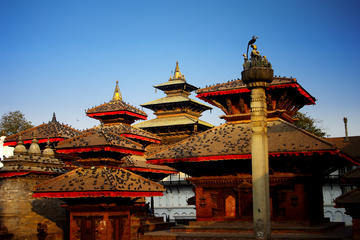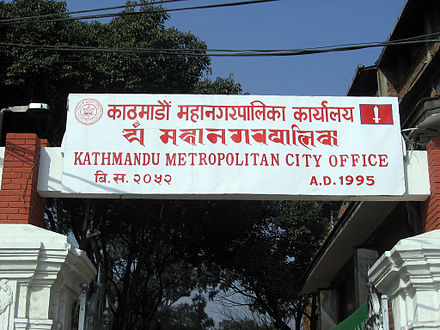Four main things come to mind when I think about
Nepal: 1) Mt. Everest, 2) Sherpa guides, 3) they have an odd-shaped flag, and 4)
the Bob Seger song “Katmandu,” named after the city Kathmandu. However, I’m
fairly certain there’s more to the country than a rock song named after its
capital and flag shaped like no other.
The name Nepal is thought to have derived from a
number of origins, including being named after a Hindu sage known as “Ne.”
Others believe it’s related to the Newari people or of other Tibetan
origins.
Nepal is a landlocked country that lies in between
the Tibetan region of China to the north and India to the south. Small areas of
India separate Nepal from Bhutan and Bangladesh. The country is divided into
three main areas: terai (plains region), hills (between the terai and the
mountains), and the mountain region (part of the Himalayan Mountains). Eight of
the worlds “eight-thousanders [8000m+]” are located in Nepal, including Mt.
Everest. Nepal’s climate is generally linked to its altitude. It also
experiences five seasons: the four traditional seasons along with a monsoon
season.
 |
| Sir Edmund Hillary (of New Zealand) and Nepalese Sherpa Tenzing Norgay |
People have trekked through the Himalayas nearly
11,000 years ago, and various Indian and Tibetan people more than likely
started living in the Nepali region about 2500 years ago. It was once under the
Tibetan Empire, but later was ruled by the Chalukya Dynasty of South India who
introduced Hinduism to the Buddhism that was already there. During the mid-18th
century, a Gorkha king by the name of Prithvi Narayan Shah worked to basically
set up Nepal as we know it. There was quite a bit of negotiations and conflicts
over borders, especially concerning a few of the northern Indian states that
border Nepal. The British East India Company certainly wasn’t happy about
giving up those states, and a war ensued. The British completely underestimated
the Nepali fighters. Starting in the mid-1800s and lasting well into the
beginning of the 20th century, different factions in Nepal fought
against each other over who should rule and how. Slavery was abolished in 1924,
which led to certain social changes. In response to the tyrannical Rana
government, pro-democracy groups popped up during the 1940s. Finally King
Mahendra had had enough of it in 1959 and enacted a “partyless” system, which
lasted until the people revolted in 1989 and forced a multiparty system in. In
1996, the Communist Party of Nepal decided to stir up the pot by trying to get
rid of the parliamentary system in lieu of a people’s republic. This led to a
civil war where 12,000 were killed. Nepal finally moved to becoming a federal
republic and secular state in 2006, losing its notoriety as a Hindu Kingdom
while abolishing the monarchy. In October 2015, Nepal chose Bidhya Devi
Bhandari as its first female president.
The capital city is Kathmandu, located in the
Kathmandu Valley. The city itself has about 1.4 million people, but there’s
about 5 million in the metro area. The city is a multiethnic community with a
mix of Hindu and Buddhist populations. Kathmandu, as well as Nepal in general,
depends on the tourism industry. It has a thriving arts scene, casinos, hotels,
museums, restaurants, and shopping areas that attract millions of people each
year. In April 2015, an earthquake that measured 7.8 on the Richter scale
devastated the city of Kathmandu.
Nepal’s economy is still highly dependant upon
agriculture. In fact, it employs nearly three-quarters of the people in some
aspect. They still have to contend with a large number of unemployed and
underemployed, though. The service sector seems to be increasing. Through many
reasons and causes, Nepal struggles with poverty and receives aid from several
countries. Its currency is tied with the Indian rupee.
Traditionally, Nepal has been a Hindu country with
a smaller number of Buddhist followers (it’s said that Buddha was born in
Nepal). The country is the site of the Lord Shiva temple, an important
pilgrimage destination for Hindus all over the world. There are actually
smaller numbers of Muslims, Christians, indigenous beliefs, and other religions
followed there as well. However, the government declared the country a secular
state in 2006.
Although Nepali is the main language spoken in
Nepal, there are a number of other languages spoken here, along with four
different sign languages! Nepali is often used as a lingua franca among
different ethnic groups and is commonly written in the Devanagari script (the same
one used for Hindi and Sanskrit). Tibetan is spoken in the regions near Tibet,
and many people in government and commerce use Maithili. In larger cities like
Kathmandu, many people understand English as well.
Nepal is certainly remote and rugged and has its
own set of cool features (no pun intended). The Nepali word for Mt. Everest is
Sagarmatha, meaning “forehead of the sky.” (Lovely name. I think I know a guy
who could go by that name, too.) The Nepalis are actually years ahead of us:
according to the Nepali calendar, it’s 2074. Roughly 20% of 13-15 year olds
smoke tobacco, which is probably why (among other reasons) their life
expectancy is only 59 years old. However, Nepal is the #1 producer of mustard
seeds and #3 producer of ginger, which probably means I’m going to love their
food.
Up next: art and literature







No comments:
Post a Comment